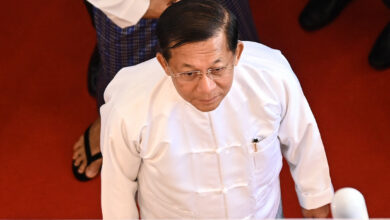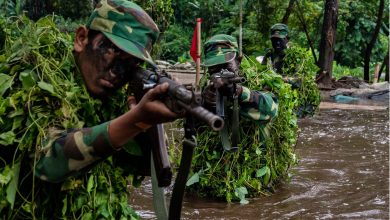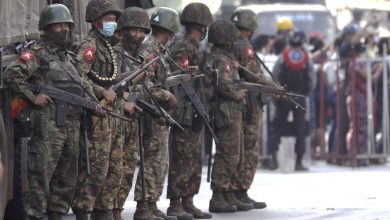
Perhaps missed in the stream of recent United Nations (UN) reports denouncing the atrocities perpetrated by the Myanmar military regime, the International Labour Organisation (ILO) in early October released its Commission of Inquiry (CoI) report. This report is potentially the most far-reaching measure to exert pressure on the military council and deserves close observation.
The ILO is one of the oldest international organizations, formed in 1919. Its structure is significantly different to the UN General Assembly and other international organizations, because it has three pillars: the governments, workers’ federations, and employers’ representatives of 187 countries.
Only 14 CoI’s have been formed by the ILO in over a century: Myanmar has had two, the first in 1998 and this current one. The first CoI made major gains in significantly reducing, but not eradicating, forced labour including the recruitment and use of child soldiers into the Myanmar military. The major difference between the two reports is that while forced labour is a key factor once again, the ILO is probing post-coup attacks on workers and unions as well. It also casts attention on the labour movement and the regime’s assault on workers’ rights. It should also act as a reminder of the key role that workers and unions played in the early days of protest against the coup d’etat, especially the Federation of Garment Workers, who were unjustly eclipsed by more prominent political and social activists.
A post-coup assault on labour rights
The ILO announced its intention to form a CoI in March 2022 after a year of public condemnation of the coup and growing alarm over the targeting of trade unionists by the military authorities. A three-member CoI panel was formed, including chairperson Judge Raul Cano Pangalangan from the Philippines, South African Judge Dhayanithie Pillay, and Dr Faustina Pereira from Bangladesh.
The CoI sought to establish potential breaches of two key ILO conventions, both of which Myanmar as a long-standing member of the organization had signed and ratified: the Forced Labour Convention of 1930 and the Freedom of Association and Protection of the Right to Organize Convention of 1948. Both of these conventions are intricately connected. As the report states, “freedom of association and the right to collective bargaining are enabling rights for the enjoyment of other rights… which are necessary for progress to be made in the achievement of fundamental principles and rights at work, including freedom from forced labour.”

The report’s findings of post-coup assault on worker’s rights and forced labour are damning in their detail. Some 484 workers, union leaders and strike leaders have been killed since early 2021. Hundreds more have been arrested and many others have been driven underground or into exile. Many senior leaders of trade unions have had their passports cancelled, including all the leaders of the Confederation of Trade Unions of Myanmar. Less than a month after the coup, the military council banned 16 unions for failing to register under the 2012 Labour Organization Law, including the all Burma Federation of Trade Unions and the Yaung Chi Oo Workers Association. Union leaders have been forced to hand over the names and contact details of their members to civilian and military regime officials. Offices have been raided and property damaged. In carefully worded detail, the report outlines what is clearly a war on organized labour since the coup. It echoes the broader war on the Myanmar people.
The State Administration Council, or SAC, as the junta calls itself, did not cooperate with the CoI process, but did communicate with regular ILO channels to deny all allegations contained in the report and previous correspondence on specific cases. Where it acknowledged that arrests of unionists did occur, it claimed it was due to their involvement in illegal activities such as the Civil Disobedience Movement (CDM).
Even for those workers who have not directly participated in anti-junta activities, the ability of unions to protect worker’s rights have been sharply curtailed to the point of no functioning legal right under Convention 87. “Written submissions received by the Commission and several witnesses reported that there are factories in which the management does not recognize or deal with the leaders of existing trade unions or dismantled unions, but has instead organized elections for workers’ representatives to join workplace coordination committees.”
The report may have focused more attention on freedom of association, but the post-coup resurgence of “widespread and systematic” forced labour illustrates the Myanmar military’s flagrant disregard for law. In addition to extreme acts such as forcing civilians to act as human shields or as porters on military operations, it has also used them “for cultivation, construction and maintenance of military camps or installations, and the provision of transport, accommodation, food and domestic work.” The report also condemned the practice of authorities forcing shop owners to open their stores on days of “silent strikes” where many people chose to stay indoors in protest, casting this as a breach of Convention 29. For many people over 30 years old in Myanmar, it must have dredged up painful memories.
The ILO’s strategy of pressure and engagement
In the not too distant past, forced labour of multiple repressive forms was commonplace in Myanmar, including the use of civilians to build roads, clear sewerage drains, and in one notorious case to rehabilitate the massive Mandalay Palace moat in the 1990s. Civilian authorities routinely ordered free labour. But the Myanmar army was markedly worse, with civilians, predominantly but not exclusively men, rounded up for military portering duties to carry supplies to the frontline, with soldiers raiding cinemas, stopping buses, and press-ganging people off the streets to fill huge quotas for routine operations or major offensives against ethnic insurgents. This also included widespread human shielding and what is called “atrocity demining”: forcing people to walk ahead of soldiers to trigger landmines or ambushes.
Almost impossible to quantify too are the thousands, if not tens of thousands, of convicts used on frontline operations by the military who disappeared, as a 2011 report by Human Rights Watch and the Karen Human Right Group detailed. The labour camp archipelago of Myanmar has also been responsible for untold deaths and disappearances for decades, with countless men dying in quarries while working under slave conditions, as an investigation by Myanmar Now in 2018 bleakly exposed.
Established in March 1997 following multiple reports of almost mediaeval practices of forced labour throughout Myanmar, the 1998 Commission of Inquiry report was a major escalation of ILO pressure on the then State Peace and Development Council (SPDC) regime. The report addressed three main issues: amending provisions of the Village Act and Town Act in line with the Forced Labour Convention of 1930, ending the practice of forced labour by all state bodies, especially the military, and ensuring punishment for the use of forced labour, as stipulated by the Penal Code.
The CoI report’s conclusions were damning, detailing the “pervasive used of forced labour imposed on the civilian population throughout Myanmar by the authorities and the military for portering, the construction, maintenance and servicing of military camps, other work in support of the military, work on agriculture, logging and other production projects undertaken by the authorities or the military, sometimes for the profit of private individuals, the construction and maintenance of roads, railways and bridges, other infrastructure work and a range of other tasks.”
The CoI also noted that a system of extortion existed for people who could not conduct forced labour. But for those unable to work or pay, “extrajudicial punishment of those unwilling, slow or unable to comply with a demand for forced labour,” punishment ranged “from money demands to physical abuse, beatings, torture, rape and murder.” It is no stretch to argue that Myanmar has returned to this scale of systematic depravity, wrenched back over two decades to the military’s unrepentant slave/master view of society.
The denials from Tun Shwe, the director general of the SPDC’s Ministry of Labour in 1998, are almost verbatim what the current military council is stating: “The Coordination Committee considers that the information provided by some organizations from anti-government circles was politically motivated, highly biased, lacked objectivity and without any goodwill on the part of those organizations.”
Continued pressure by the ILO for the SPDC to engage on forced labour and institute all the reforms as outlined in the CoI report incrementally produced progress. The SPDC initially refused to admit the full scale of forced labour. In 2000, the ILO imposed sanctions on Myanmar with a resolution that called for all member states and organizations to “review, in the light of the conclusions of the Commission of Inquiry, the relations that they may have with [Myanmar] and take appropriate measures to ensure that [Myanmar] cannot take advantage of such relations to perpetuate or extend the system of forced or compulsory labour.”
This was the first time in its history that the ILO invoked Article 33 of its constitution, which states that, “failing to carry out within the time specified the recommendations…the Governing Body may recommend to the Conference such action as it may deem wise and expedient to secure compliance therewith.”
In 2002, the SPDC agreed to the establishment of an ILO Liaison Office. This was during a brief period of regime “openness,” when Aung San Suu Kyi was freed from house arrest for a year before the junta staged a brutal assassination attempt on her in Depayin in Sagaing Region. Relations with the ILO deteriorated. By 2005, ILO personnel were receiving crude death threats in Yangon, and the then Union Solidarity and Development Association was staging public rallies, often (without irony) forcing people to attend.
The ILO reported that the regime was planning on leaving the world body, which would have had dire consequences for Myanmar (only three countries have temporarily left the ILO: South Africa, the United States, and Vietnam). The then ILO representative Richard Horsey has carefully detailed all these events in his 2011 book, Ending Forced Labour in Myanmar, which includes absurd details such as the use of Mickey Mouse stationary to issue death threats.
By 2007, the ILO had reached agreement on a Supplementary Understanding with the SPDC, which crucially had the establishment of a complaints mechanism which would “formally offer the possibility to victims of forced labour to channel their complaints through the services of the Liaison Officer to the competent authorities with a view to seeking remedies available under the relevant legislation and in accordance with the Convention.” This was a major step towards eradicating a widespread practice in the country and injected confidence in Myanmar’s beleaguered labour movement.
The ILO was pivotal in the mechanism of demobilizing child soldiers from the Myanmar army: nearly 1,000 were formally released after 2012. The significant progress of the ILO in ending forced labour and releasing forcibly recruited children is predominantly due to the approach of Liaison Officer Steve Marshall (who subsequently became New Zealand’s ambassador to Myanmar) and his deputy Piyamal Pichaiwongse. There aren’t too many UN personnel posted to Myanmar that can truthfully say they saved hundreds of lives and helped to reduce modern-day slavery.
After Suu Kyi’s National League for Democracy (NLD) formed a government in 2016, it attempted to “normalize” relations with the ILO by calling for the transformation of the Liaison Office to a full Country Office, which would have taken Myanmar out of the purview of the Governing Body and into the mainstream without as much scrutiny.
In December 2018, the ILO’s Complaints Mechanism was permitted to expire, but the NLD announced plans to adopt a national mechanism that permitted reports of forced labour to continue through the ILO. This effectively walked back years of ILO progress, support for the development of the union movement, and the demobilization of hundreds of child soldiers.
Like many others, the ILO fell prey to widespread over-optimism about the reformist tendencies of the NLD, which as the ruling party turned out not to be a friend of organized labour at all. The NLD was always perturbed by the prospect of a labour-based political party emerging as a challenger to its predominant position. This could have been behind Suu Kyi’s strange decision to appoint Thein Swe, an MP from the military-backed Union and Solidarity Development Party, to head the Ministry for Labour, Immigration and Population in the first NLD cabinet from 2016 to 2020. A retired major general who graduated from the 13th intake of the Defence Services Academy, Thein Swe had served in the military from 1967. From 2005 to 2010, he was the SPDC’s transport minister—a role in which he was certainly familiar with, and likely complicit in, the use of forced labour.
The Ministry of Labour claimed that by 2019, Myanmar had “2,887 basic labour organizations, 161 township labour organizations, 25 regional or state labour organizations, nine labour federations and one labour confederation” legally registered. They are all now effectively banned by a network of repressive laws.
Speak softly but carry a big stick
The ILO has given the regime the standard three months to respond to the CoI report’s conclusions and recommendations. The SAC is likely to take this seriously and not rely on the petulant yet perfunctory responses it has made to other UN reports, but mount a more detailed defence and denial strategy. Under the ILO Constitution Article 33, used in 2000, the SAC could be dragging the country back to the stand-off of 2000.
The regime has reacted with evident unease. Three committees have been formed to respond to the CoI report and prepare to deal with almost certain ILO pressure. In October, junta-controlled media claimed that in the first nine months of 2023, 150 labour disputes were solved in 44 townships, with 363 workers given a total of $48,000 in compensation. This smacks of an attempt to assemble positive spin stories to respond to the CoI report in early 2024.
The ILO is the international mechanism that the SAC is most concerned about. This is not to underplay other efforts, such as those of the UN’s Office of the High Commissioner of Human Rights (OHCHR) or its special rapporteur, Tom Andrews, which have received a significant amount of attention; but the ILO CoI has far greater potential ramifications for the SAC.
The reports of the Independent International Fact Finding Mission (IIMM) have also made important headway, including leading to the establishment of the Independent Investigative Mechanism for Myanmar. There are also the ongoing proceedings in the International Court of Justice (ICJ) over potential breaches of the Genocide Convention, and the case in the International Criminal Court (ICC) for the crime of forced deportation of Rohingya Muslims under the Rome Statute. However, these legal actions and a plethora of “universal jurisdiction” cases have little chance of actually nabbing senior regime officials, even if that are important in raising awareness on the desperate situation in Myanmar.
All of this reporting and legal manoeuvring has only the remotest chance of succeeding, if the measure of success is to stop atrocity crimes and bring perpetrators to justice. Tom Andrews and the OHCHR seriously needle Myanmar bureaucrats and officials, but they can apply little direct pressure, beyond informing targeted sanctions efforts, which is a major contribution. The ultra-expensive IIMM may never actually release all of its high evidentiary threshold case files. The ICJ is simply ruling on whether breaches of a convention can be proven. And the ICC takes years to produce anything resembling individual responsibility for war crimes. The ILO’s engagement may be similarly slow, but its past efforts illustrate how much more it can achieve.
The state media touted in recent days the surge of profits in the garment sector between April and September, with US$4.316 billion in exports of cut, make, pack (CMP) goods, mostly to Japan and South Korea. However, if the ILO spurs international unions to action, especially the powerful International Transport Workers Federation, and refers Myanmar to the ICJ for non-compliance, it could face a significant intensification of pressure. As sanctions continue to bite, the economy deteriorating, and rising commodity prices, the junta leadership faces further uncertainty.
David Scott Mathieson is an independent analyst working on conflict, humanitarian and human rights issues on Myanmar



